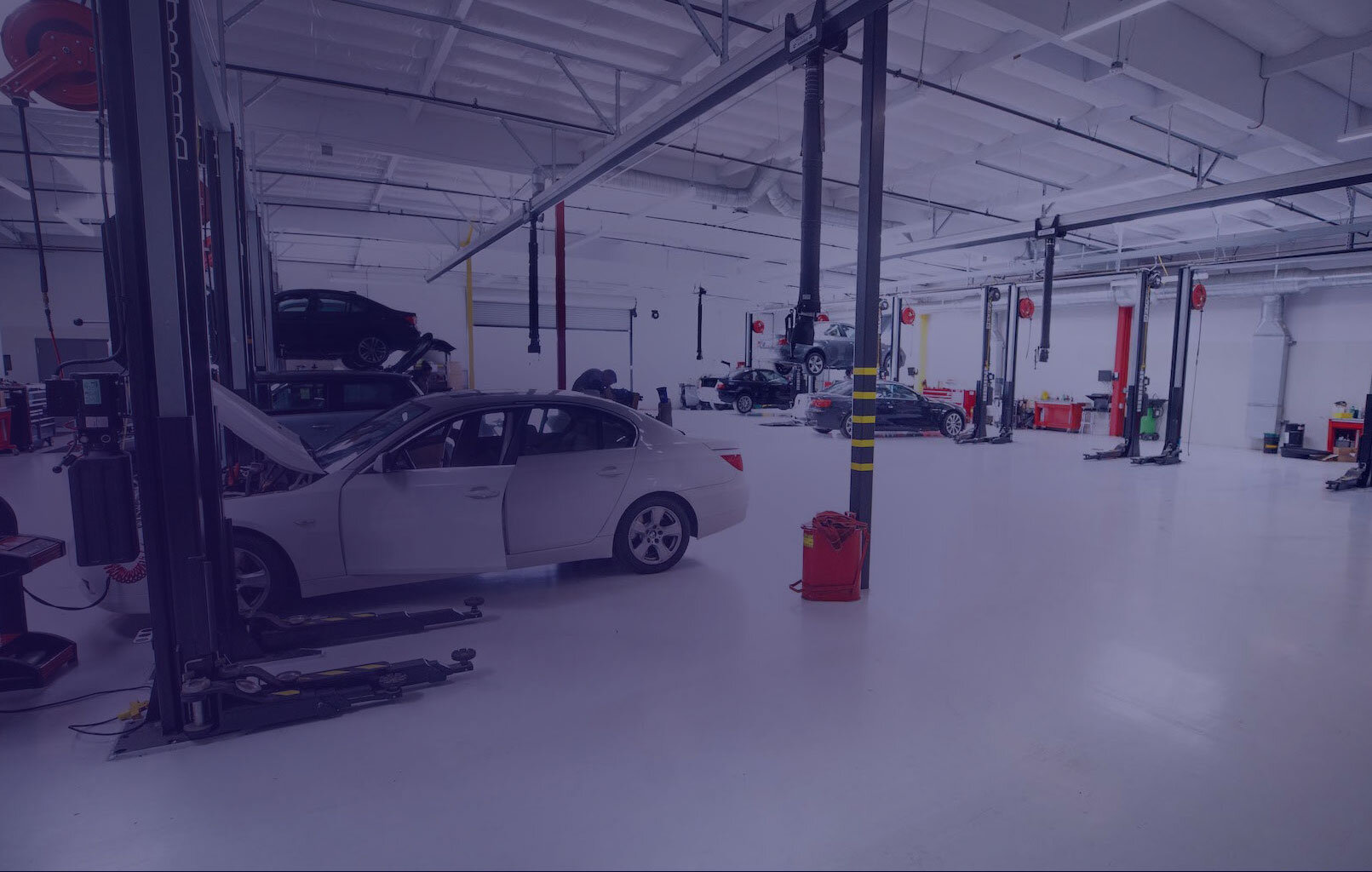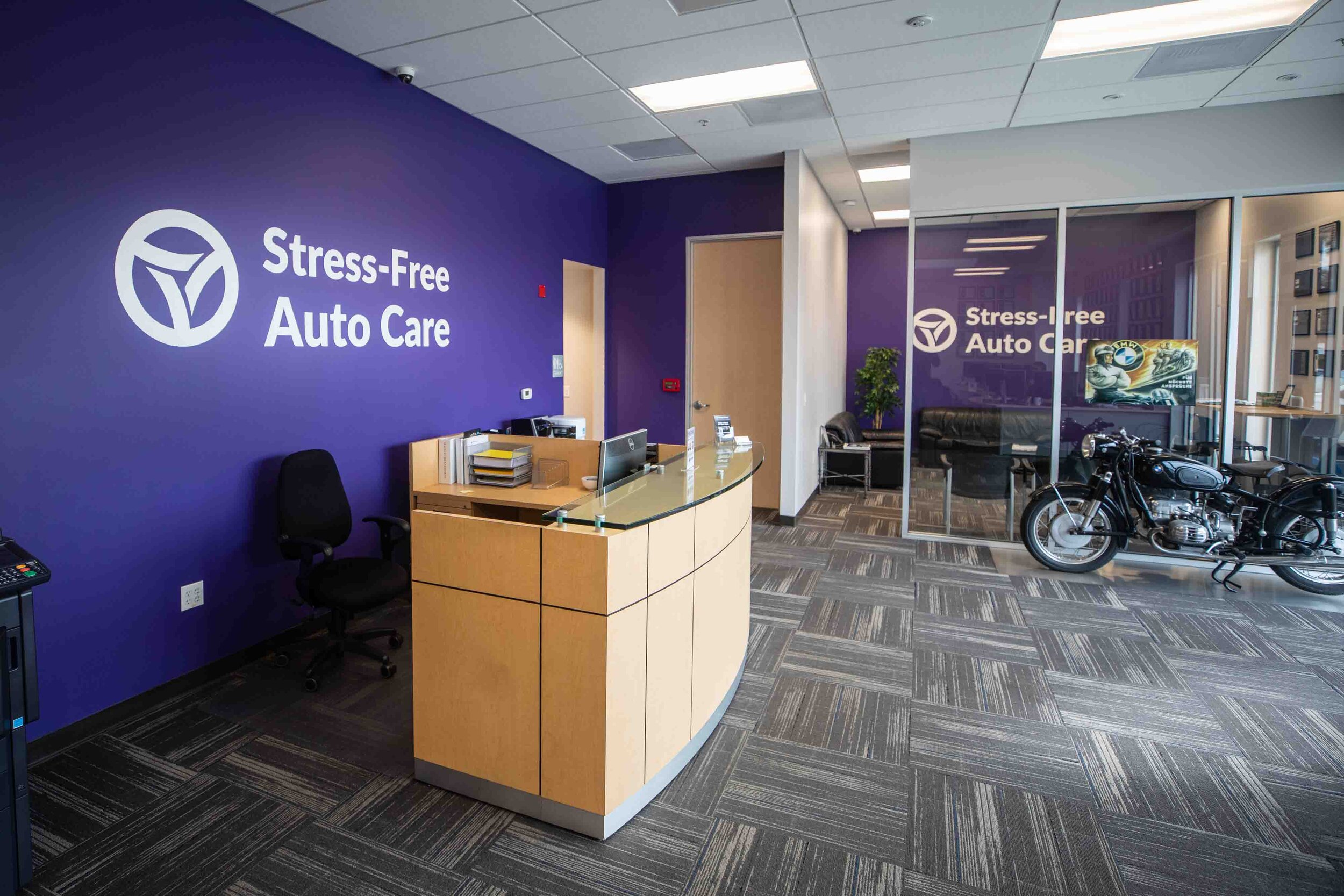
Trusted Brake Service to Keep you Safe on the Road
Experts in brake maintenance and replacement
The brakes on your vehicle are the most important part of your car when it comes to safety. Without healthy brakes, you are at increased risk of an accident and damage to other parts of your vehicle. The team at Stress-Free Auto Care is ready to take care of all your brake needs, so come on in and experience the stress-free difference.
Stress-Free Advantage
Transparent Pricing
Text Updates
Digital Inspections with Pictures
Live Video Feed of Your Repair
Pay By Text Available
Comprehensive Brake Service Package
1. Brake Pad Replacement
2. Resurface or Replace Rotors
3. Drain & Refill Brake Fluid
$525 - $1290 per axle* **
Typical service length: 2 - 3 hrs (per axle)
Assuming you have an appointment.
*Depending on the part price. If rotors cannot be resurfaced, replacement may be necessary, and would move the price toward the higher end of the range.
**Axle can be front or rear
Brake Diagnostic FAQs
Brake Fluid FAQs
Brake Pad Replacement
$299- $649 per axle* **
*Depending on the part price. Note that most expert technicians do not recommend this repair, and it can result in brake squeak post service.
**Axle can be front or rear
Typical service length: 1 - 2 hrs (per axle)
Assuming you have an appointment.
Brake Pads FAQs
Comprehensive Brake Inspection
Check your front and rear pads, rotors, callipers, shoes/drums, hardware, hoses, brake lines, fittings, master cylinder. valves, and sensors.
$64 to $99 per inspection
Covers all 4 brakes
Typical service length: 45min - 1 hr
Assuming you have appointment
Brake Caliper FAQs
Brake Rotor FAQs
About Our Brake Service
Book Online and Save
Apply any of the following coupons when making an online appointment and save.
Individual coupon cannot be redeemed or combined with other offers.
BRAKE DIAGNOSTIC
+ How do I know if something is wrong with my brakes?
Actually, you might not know for sure until a qualified mechanic is able to inspect your braking system. However, a few common systems might tip you off: noise from your brakes (squeaks and grinding noises are perhaps the two most common), a shuddering or vibration only when you apply the brakes, or a brake pedal that isn't very "firm" (you have to press it pretty hard in order to get your vehicle to stop) are all things that we see a lot.
+ Should I just get my brakes replaced?
At Stress Free Auto Care, we generally recommend starting with a diagnostic, which usually covers about a half hour of time for the technician. Because a good brake diagnostic requires partial disassembly of the braking system, it can usually be credited toward any repair. If we find out it's something trivial (sometimes, it's just brake dust on the pads causing a squeak, and there's no problem at all!) you can save some money, too.
+ What happens during a brake diagnostic?
If you have a noise concern, you can make sure the technician knows to listen for that same noise, so he can make sure to evaluate the issue appropriately. No matter what, the technician will put the vehicle on the rack, and take off the tires in order to inspect the brake pads and rotors more closely. During this inspection, the technician can identify whether the issue is minor (like a small amount of rust from the rotors) or something more important (for instance, your brake pads have become too thin, and are below the manufacturer specification).
+ What usually malfunctions with my brakes?
Your vehicle comes equipped with brake pads and rotors, and the pads (and to a lesser extent, the rotors) are wear and tear items; the more you use them, the more they wear out and the sooner they require replacement. Generally, that is the most common repair that we see with someone's brakes. The other thing you will often need to do is replace your brake fluid. Many manufacturers put this on the maintenance schedule, but brake fluid can also become contaminated over time. If that contamination comes with moisture in the brake fluid, it might be time to replace that fluid so that the power from you pressing the pedal is appropriately amplified to stop your car!
BRAKE PADS
+ What is a brake pad?
A brake pad consists of a metal backing plate with friction generating material bonded or riveted to one side of it. There are three main types of friction material for modern brake pads. The first and most common being semi-metallic, which is composed of metals including iron, copper, steel, or other composite alloys. The next material is organic, which is made of a mixture of fibers and materials such as rubber, carbon compounds, glass or fiberglass, and Kevlar. Lastly, the high performance option is ceramic brake pads which are typically installed on higher end luxury/sport vehicles. They are composed of dense ceramic and copper fibers.
+ How do brake pads work?
The wheel, tire, and brake rotor are bolted to the wheel hub, and these components all rotate in unison when driving. Brake pads are mounted inside of a brake caliper bracket and are positioned both on the inside and outside of each rotor. When braking, a piston located in the caliper pushes the brake pads toward each other and squeezes the rotor. Kinetic energy of the spinning rotor is converted to heat energy. The friction on the rotor causes the vehicle to slow down and come to a stop.
+ What can go wrong?
Brake pads are a common replacement item on vehicles due to normal wear and tear. Every time the driver applies the brakes, the brake pad friction material wears away ever so slightly, until eventually reaching its minimum thickness. Hard and frequent braking will cause brake pad replacement to be required more often. Occasionally, things other than normal wear and tear can cause a brake pad to need replacement. Brake pads can sometimes become saturated with hydraulic brake fluid in the event that there is a leak. In any case where the brake pad friction material has been contaminated by hydraulic brake fluid, replacement of the brake pads will be necessary. Another reason for replacement is if cracks or missing parts in the friction material are found. This has become increasingly rare over time, but is still a possibility.
+ How do you know if it needs work?
Although some brake noise may be normal, such as a light squeak in the morning, noise can also be a great indication that brake work is needed. Some brake pads are equipped with a pad wear indicator or "squealer", which is a metal tab that will squeal by contacting the rotor due to the pad wearing below the minimum thickness. A grinding noise when the brakes are applied usually means the friction material has worn completely down, creating a very unsafe situation. This is commonly referred to as "metal to metal.” Additionally, some manufacturers equip their vehicles with electronic wear sensors which insert into the brake pad. When the brake pad wears down to its minimum thickness, a wire inside of the plastic sensor will wear down as well to create an opening in the electrical circuit. This opening alerts the vehicle that brakes are needed and the vehicle will then prompt a brake pad warning for the driver. During routine vehicle service, the brake pads are commonly measured and inspected for any signs that work is needed. Brake pads are always replaced as a set per axle.
BRAKE FLUID
+ What is brake fluid?
Brake fluid is a type of hydraulic fluid used in automotive brake and clutch systems. It is used to transfer force into pressure, and is capable of doing this because it, like all other liquids, is not able to be compressed.
There are two main types of brake fluid in use today, with the first and most common being glycol-ether based. This brake fluid is sold and labeled as either DOT 3, DOT 4, or DOT 5.1 Brake Fluid. The different numbers in the fluid indicate as they go higher the fluids’ ability to resist boiling. Therefore, DOT 5.1 brake fluid will resist boiling in the automotive brake system at much higher temperatures than will DOT 3 brake fluid. All of these fluids are interchangeable and mixable, but the ability to resist boiling is diminished if a lower level fluid is used.
The other main type of brake fluid is silicone based, and is labeled and sold as DOT 5 brake fluid. This brake fluid is NOT interchangeable or mixable with other types of brake fluids. One advantage of silicone based brake fluid is its ability to resist moisture absorption, which is an issue for other brake fluids. Despite its superior ability to resist moisture absorption, DOT 5 brake fluid is in limited use in modern day vehicles.
+ Why is brake fluid important?
Without brake fluid, a driver would not be able to stop their vehicle in the manner they are used to. Brake fluid is directly responsible for carrying the force from the driver pushing on their brake pedal, and transmitting it as pressure to the brakes on the car.
+ What can go wrong with brake fluid?
Glycol-ether based brake fluids (the most common type) are hygroscopic in nature, meaning they absorb moisture. From general cooking, most people know that water boils at 212 degrees Fahrenheit. Brake fluid has to be able to resist boiling at over 400 degrees Fahrenheit. The humidity in the air over time contaminates brake fluid, and gradually reduces its boiling point as the moisture concentration increases. If the brake fluid boils and changes into a gaseous state, it can then be compressed – this would feel like the driver of a vehicle hitting the brake pedal, but the car does not slow down.
Other than boiling, brake fluid must be contained in order for it to allow the system to operate under pressure. Any type of leak will prevent the brake fluid from getting its job done. Usually small leaks will be noticed by a driver as a change in the feel of the brake pedal.
+ How do you know when brake fluid requires attention?
During regular service intervals, automotive technicians routinely inspect the brake fluid on vehicles for: condition, level, and leaks. Using modern testing equipment, technicians can measure the moisture content of the brake fluid by taking a sample from the vehicles’ brake fluid reservoir. When the moisture content is at or above 3%, a brake fluid exchange service is generally recommended.
Some manufacturers have also incorporated brake fluid exchange services into the maintenance schedule for their vehicles. These service intervals are generally every two or three years, regardless of mileage.
Additionally, if a brake fluid leak is discovered during a routine vehicle service, it should be immediately corrected to ensure proper braking performance of the vehicle. A driver may also notice a change in the way the brake pedal feels when a leak is present. Any sudden change in the feel of the brake pedal is grounds for inspection by a technician to ensure everything is in working order.
+ How long does a service take and why?
A brake fluid exchange service generally takes an automotive technician about one hour to complete. Based on the shop’s workload, your vehicle can usually be returned to you in a few hours.
+ What other work might be associated with this service?
Anytime hydraulic parts of the brake system are replaced (such as brake calipers, brake hoses, and metal brake lines), a brake fluid exchange service is needed to clear the air out of the brake system following repairs. Additionally, this service may be part of a routine maintenance service on your vehicle, and combined with other maintenance services, such as oil and filter changes.
+ Does the type of vehicle matter?
When performing service to the brake fluid on a vehicle, an automotive technician must verify the correct fluid to use for your vehicle. Each vehicle has a different fluid specified for use, and a technician will generally use the fluid specified by your vehicle manufacturer.
It is important to note that some auto repair facilities may install DOT 4 brake fluid as their standard replacement fluid. This is becoming more common in the auto repair industry. If your vehicle calls for DOT 3 brake fluid, and a shop installs DOT 4 brake fluid, this is an acceptable substitute and can even be considered an upgrade. Since there is negligible difference in price between these fluids, you can rest easy knowing your brake system has that much more resistance to boiling brake fluid.
There are some vehicles with advanced braking systems (Mercedes Benz SBC, for example) that have additional service requirements for the brake fluid. For high end braking systems, please be sure to always have a trained technician for that specific system perform the work.
BRAKE CALIPER
+ What is a brake caliper and what does it do?
In a disc brake system, 3 of the key components that work together are the brake calipers, brake pads, and brake rotors. The brake caliper’s job is to use the hydraulic pressure generated in the brake system when a driver pushes on the brake pedal to squeeze the brake pads against the brake rotor at high pressure. This process of squeezing the brake pads against the rotors is vital to the operation of a modern disc brake system.
It’s important to know that there are two basic types of brake calipers in use on modern day vehicles: fixed brake calipers and floating calipers. A fixed brake caliper mounts over a portion of a brake rotor, and has pistons which extend with brake pedal application to apply equal pressure to brake pads on both sides of the brake rotor.
A sliding (or floating) brake caliper has a piston that applies pressure to the inside-oriented brake pad directly and pins on which the assembly slides to transfer the braking force to the outboard brake pad.
A sliding brake caliper is more commonly found on light duty passenger vehicles, while fixed brake calipers are typically found on higher performance vehicles due to their more robust and equal application of pressure to the inboard and outboard brake pads.
+ Why is this important?
Brake calipers are crucial in administering the force of the braking system when you stop your vehicle from any speed, and on any surface.
+ What can go wrong?
Luckily, brake calipers are fairly simple in design and require little to no maintenance under normal driving conditions. Failures of brake calipers are not very common, but occasionally happen for a few reasons. The most common reason a brake caliper is replaced is because one of the pistons (which extend to provide pressure to a brake pad) becomes seized in the bore of the brake caliper. When the piston is seized and can not move, the caliper is unable to apply pressure to the brake pad; not applying pressure to a brake pad when the driver pushes on the brake pedal increases stopping distance, as well as makes the vehicle handle abnormally during braking.
Brake calipers are also sometimes found leaking from their primary square cut seal around the piston. This seal not only confines the hydraulic brake fluid inside of the caliper assembly, but is also responsible for slightly retracting the piston of the brake caliper once the driver of a vehicle releases the brakes. A failure of the square cut seal is rare, but also an issue which will cause noticeable change in the feeling of the brakes during operation.
Inspection of the brake calipers, and retraction of the pistons is routine at every auto repair shop when brake repairs are being made.
+ How do you know when it needs work?
When a driver depresses the brake pedal to slow or stop their vehicle, and experiences a pull in a left or right direction, it is possible that a brake caliper is responsible for this. While many other components on a vehicle can cause this to happen, inspection of the brake calipers is important to rule out the possibility of a brake caliper issue.
Additionally, when an auto repair shop is servicing the brake system on a vehicle, a technician has to retract the pistons in order to install new brake pads; brake calipers are also inspected for leaks at this time. If a problem is noticed during this procedure, it is important to correct the issue by either repairing or replacing the brake caliper to ensure the proper operation of a vehicle’s brake systems.
+ What other work might be associated with this?
When replacing a brake caliper on a vehicle, a brake fluid exchange service will be required in order to clear the air from the hydraulic brake system. Brake calipers are also sometimes replaced when an issue is discovered during a routine brake job. Lastly, rubber brake hoses may also be suggested for replacement based on their condition when a brake caliper is replaced.
+ Does the type of vehicle matter?
In terms of the basic principles of operation, the brake caliper operates the same way on the vast majority of vehicles in use today. The biggest differences between vehicles is the cost of the brake caliper itself, and the style of brake caliper used.
BRAKE ROTORS
+ What is a brake rotor?
At the most basic level, a brake rotor is a round metallic component with a machined surface that is attached to the wheel hub on the vehicle. If you have ever looked through the spokes of your wheel and seen a shiny metal disc, that is your brake rotor. They are almost always found on the front axle of modern vehicles, and increasingly found on the rear axle as well.
During operation, brake pads with friction material are pressed against the brake rotor by a brake caliper, using hydraulic pressure generated by the master cylinder and transferred to the caliper via rubber hoses and metal lines. The friction caused by pressing the brake pad against the rotor generates heat energy. This heat energy is absorbed, and then dissipated by the brake rotor. This happens every time you push on your brake pedal in your vehicle to slow or stop the car.
Essentially, the job of the brake rotor is to absorb, and dissipate heat energy every time you use the brakes on your vehicle.
+ Why is this important?
Having functioning brakes on your vehicle is paramount to safely driving on all types of roads, and in all traffic conditions.
+ What can go wrong?
The most common reason a brake rotor is no longer usable is simply wear and tear. Brake rotors are subject to wear every time the brakes are applied while driving your vehicle. Over time and repeated application, the brake rotor material is gradually worn away.
Most European vehicle manufacturers recommend replacement of the brake rotors with any brake pad replacement, while Asian and domestic manufacturers generally allow the brake rotors to be resurfaced if it meets the minimum thickness specification. If below the specified minimum thickness, it requires replacement as well.
Other reasons for brake rotor replacement include being warped beyond the ability to resurface from repeated heavy usage. When any metal is constantly heated beyond its tolerance and then rapidly cooled, the surface becomes warped over time. This can happen on your vehicle at high brake demand instances, such as when driving in hills or mountains, towing a boat or trailer, or when your vehicle is carrying additional cargo.
Rarely, brake rotors can develop cracks in the machined surface. Whenever a crack is present in a brake rotor, replacement is required to safely correct the issue and ensure proper braking performance.
+ How do you know when it needs work?
If a brake pad replacement procedure is being performed on your vehicle, the brake rotors will either need to be replaced, or resurfaced to ensure proper braking on your vehicle. If the brake rotor measures above the minimum thickness specified by most Asian and Domestic manufacturers, it can be resurfaced and reused. After machining the brake rotor, an automotive technician must verify the rotor is still above the minimum thickness specification by measuring the brake rotor with a micrometer.
On most European vehicles, replacement of the brake rotor is called for when the brake pads are replaced. Resurfacing and reusing the brake rotor is generally not recommended in the repair manuals of these vehicles. By always using a new brake rotor, the manufacturer is ensuring that your new brake rotor can absorb and dissipate the most possible amount of heat, which is its primary responsibility.
Additionally, if you press on your brake pedal during normal driving and feel a pulsation in the pedal, this could be a sign that the brake rotor is starting to warp and requires attention. It may also need inspection if you are hearing any abnormal squeaking from the brakes when they are applied
+ What other work might be associated with this?
We have learned that the brake rotor operates as a part of the braking system on the vehicle, and as such it is common to replace or resurface a brake rotor with other brake repair procedures. The most common other item seen during replacement of the brake rotor is the vehicle’s brake pads.
If replacing any of the rubber brake hoses or metal brake lines at the same time, a brake fluid exchange is also needed to clear the air from the lines.
+ Does the type of vehicle matter?
There are a few applications that this article doesn’t totally account for, such as when electronic parking brakes/sensors are present, exotic and performance vehicles using high performance compound brake rotors, or on a Mercedes-Benz SBC brake system. While additional labor charges and material charges are common on these applications, the basic principles are still the same.
Stress-Free Auto Care
Instant online booking.Limited waiting time in the shop.Pay up to 30% less than the dealership.










